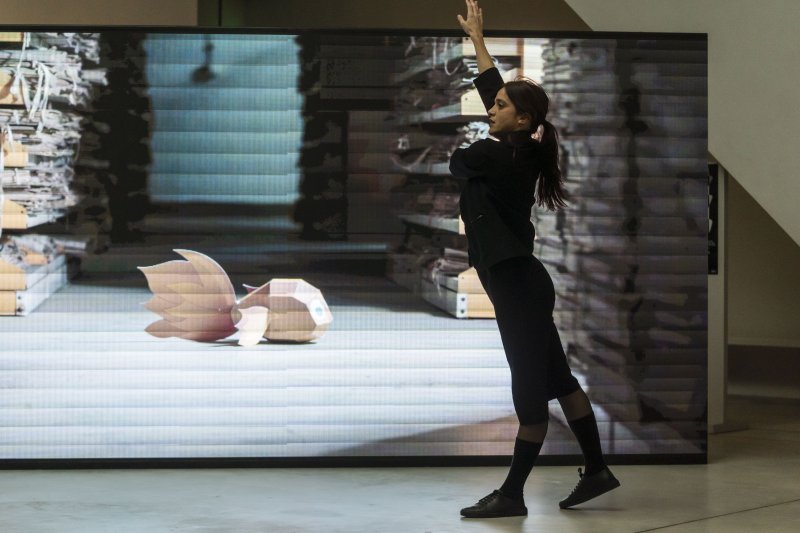Gestus, an exhibition project at the Teatrino di Palazzo Grassi
In 2021 the Teatrino di Palazzo Grassi has explored a new field of activity, presenting its first site-specific exhibition project: "Gestus", curated by Video Sound Art.
In 2021, the Teatrino di Palazzo Grassi has explored a new field of activity, presenting its first site-specific exhibition project: Gestus, curated by Video Sound Art. The new format, designed specifically for the Teatrino, presented a collective show incorporating video works, installations and performances by the artists. Conceived as an ever-evolving body, the exhibition consisted of two acts - as per the tradition of theatrical performances - each of which featured two artists, joined by a chorus of performers.
"Gestus" was a collective show that takes inspiration from the reflections on the body started by the great masters of theatre of early 20th century, such as Artaud, Copeau, Decroux, Mejerchol'd. The selected works questioned the physical language as activator of transformative dynamics: break up physical and mental automatisms, deconstruct the body to build it back, giving birth to utopia that subvert the natural order of things.
The actor must express both the action that they are performing and the possibility of another action that is not performed.
Bertolt Brecht
“Gestus I atto: Rifare il corpo”
From 15 October to 24 november 2021, "Gestus I atto: Rifare il corpo", the first act of the exhibition "Gestus", included performances by artists Enrique Ramirez, Caterina Gobbi and Andrea di Lorenzo dedicated to the body, its identity and its relationship with other forms of life.
The first act - (Refashioning the Body) - drew its inspiration from the use of the neutral mask, as originally used by Jacques Copeau in performative exercises. The mask allows the actors to experiment with the effectiveness of physical action, using the growing movement of the torso as activated by the breath. The being is reborn without a face and moves like the moon through the sky, never adapting to anything outside itself, but rather reterritorialising itself, changing its very structure. The primary aim is to break up its physical and mental automatisms, taking the body apart like a machine before putting it back together.
Enrique Ramirez and Luca Trevisani reflected on Artaud’s guiding idea in the The Theatre of Cruelty: refashioning the body to restore it to freedom in its truest sense, to bring it to its senses. Moving alone is not enough. It is an exploration of physical actions, an attempt to broaden perceptions and redefine the confines of the world. In this contest, the chorus - Caterina Gobbi and Andrea Di Lorenzo - pushed the body beyond physical and sensory boundaries in an attempt to approach non-human forms of life. The underpinning desire is that of reshaping its own nature, to become capable of forging new connections.
“Gestus II atto: Il montaggio delle azioni”
The second act, "Gestus II atto: Il montaggio delle azioni", was presented from 1 December to 15 January 2022, with works by Ludovica Carbotta and Driant Zeneli and performances by Ludovica Carbotta with Benedetta Barzini, Annamaria Ajmone and Driant Zeneli. The artists of the second act of "Gestus" explored unprecedented new ways of existing in the world, moving beyond appearances to observe the deep-seated structures that govern human behaviour. The works reflected upon the physical exploration of urban space, proposing models for utopian cities and upending the concept of justice to create paradoxical dynamics.
Power dynamics and History are interwoven with individual narratives, creating utopias which subvert the natural order of things. Heretofore alien positions, gestures and thoughts become an integral part of everyday consciousness. Much as plants are capable of engulfing the elements around them and melding into one another, so too does the new organism create a two-way connection with the environment that it is part of. The chorus - Annamaria Ajmone with performances from Carbotta and Zeneli - use intergenerational physical testimonies to make the body into a fully-fledged political space, where the needs of the individual and the community are renegotiated.
